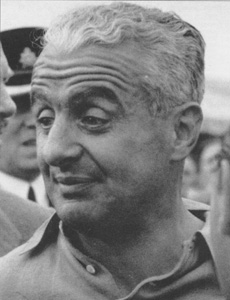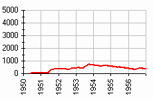Гонщики, V | |
Villoresi, Luigi Курсивом отмечены гонщики, |
| Луиджи ВиллорезиVilloresi, Luigi |
 (c) 'Who is Who' by Steve Small, 2000 Родился: 16.05.1909 Милан Умер: 24.08.1997 Модена Сезонов в Ф1: Лет в Ф1: 7 Гран При: Старты: 31* *не стартовал: 3 Победы: - подряд: Подиумы: - подряд: 3 Поул-позиции: - подряд: Первый ряд: - подряд: 2 Быстрые круги: - подряд: Лучший финиш: Лучший старт: 2 Дубли: Хет-трики: Лидирование старт/финиш: Большие шлемы: Круги: - лидирования: 2 Километры: - лидирования: |
Год | Команда | Шасси |
Success and tragedy in equal measure marked the 25-year career of 'Gigi' Villoresi, the silver-haired Italian who was at his zenith in the immediate post-war era. He began racing back in 1931 with Fiats before turning to the marque that would make his name: Maserati. That was in 1936, and by then he and his brother Emilio had established a reputation as a pretty wild pair. Nevertheless Luigi won the voiturette Brno GP in Czechoslovakia in 1937 to earn promotion to the Maserati Grand Prix team. He became the 1500 cc Italian champion in 1938 and 1939, and took wins in the Albi, Pescara and South African GPs. He also won the Targa Florio in both 1939 and 1940, again in a Maserati, but the period was clouded by the death of Emilio, who was by now racing as a rival in the Alfa Romeo team.
During the war Villoresi was held as a prisoner of war, but upon his release he was immediately looking to race again. He and Farina soon vied for the title of Italy's fastest driver, and with Wimille he was regarded as the world's best. In 1946 he scored victories in Nice and the Circuit of Voghera with his Maserati and took a 3-litre 8CL to Indianapolis, where he finished seventh, and the following season he notched up wins at Buenos Aires, Mar del Plata, Nimes, Nice, Strasbourg and Luxembourg. The 1948 season saw him suffer a major crash at Bremgarten which he was lucky to survive, though he was to triumph as Italian champion for the second successive year. Wins were recorded at Buenos Aires in two races, Comminges, Albi, Silverstone (the first post-war British GP) and Barcelona. After winning the Libre races at Interlagos and Gavea, Villoresi finally forsook his beloved Maserati to join Ferrari along with Ascari, to whom he passed on much of his racecraft. He was soon winning races for the Scuderia at Zandvoort in the supercharged car and in Formula 2 at Brussels, Luxembourg, Rome and Garda.
The 1950 and 1951 seasons were spent chasing the Alfa Romeos, but Villoresi still found success aplenty; wins at Buenos Aires and Rosario were followed by more success at Marseilles, Erlen and Monza in 1950, while the following year saw a very consistent championship campaign with the Type 375, which he took to victory at Syracuse and Pau in non-title events. It was a good year for 'Gigi', for he won the Mille Miglia and was second in the Carrera Panamericana, and shared a Lancia with Ascari to win the Sestrieres Rally. During 1952-53 he was forced sit in the shadow of his brilliant pupil Ascari, but could still do the job when required, taking wins at Turin and Modena.
Villoresi signed for Lancia for the 1954 season along with Ascari, but they were forced to wait for their Formula 1 car, which failed to appear until the last Grand Prix of the season. 'Gigi' raced for Maserati in the interim, but a crash in the Mille Miglia had dulled his edge. He continued with the Lancia concern in 1955 but, after the death of Ascari and the subsequent amalgamation of the team with Ferrari, found himself out of a works drive when the 1956 season began. By now well past his best, he drove privateer Maseratis and the works OSCA in sports car events. It was in this form of racing, driving a Maserati, that he suffered yet another serious injury when he crashed at Castelfusano and broke his leg very badly. Begged by his family to retire, he deferred to their wishes, but couldn't resist taking part in the 1958 Acropolis Rally, which he won in a Lancia.
(c) 'Who is Who' by Steve Small, 2000
| © WildSoft, 1995-2020 |


